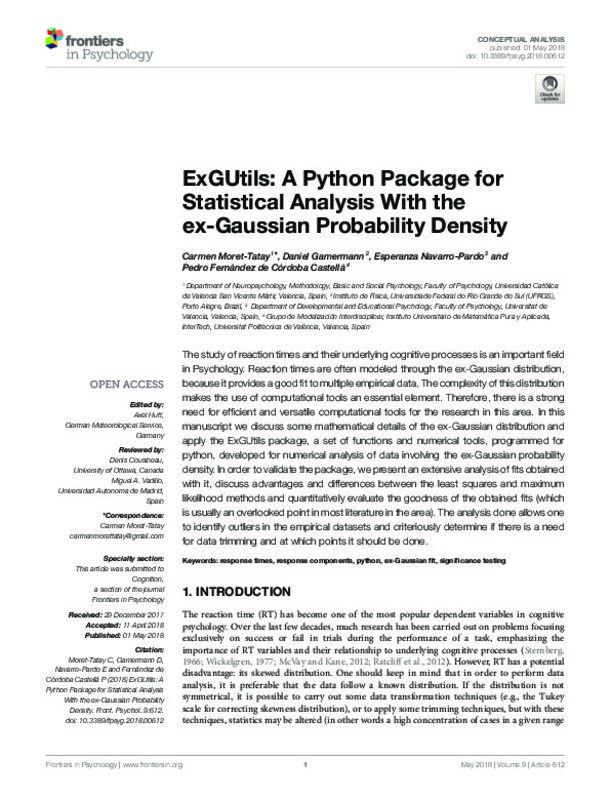Balota, D. A., Cortese, M. J., Sergent-Marshall, S. D., Spieler, D. H., & Yap, M. J. (2004). Visual Word Recognition of Single-Syllable Words. Journal of Experimental Psychology: General, 133(2), 283-316. doi:10.1037/0096-3445.133.2.283
Clauset, A., Shalizi, C. R., & Newman, M. E. J. (2009). Power-Law Distributions in Empirical Data. SIAM Review, 51(4), 661-703. doi:10.1137/070710111
Cousineau, D., Brown, S., & Heathcote, A. (2004). Fitting distributions using maximum likelihood: Methods and packages. Behavior Research Methods, Instruments, & Computers, 36(4), 742-756. doi:10.3758/bf03206555
[+]
Balota, D. A., Cortese, M. J., Sergent-Marshall, S. D., Spieler, D. H., & Yap, M. J. (2004). Visual Word Recognition of Single-Syllable Words. Journal of Experimental Psychology: General, 133(2), 283-316. doi:10.1037/0096-3445.133.2.283
Clauset, A., Shalizi, C. R., & Newman, M. E. J. (2009). Power-Law Distributions in Empirical Data. SIAM Review, 51(4), 661-703. doi:10.1137/070710111
Cousineau, D., Brown, S., & Heathcote, A. (2004). Fitting distributions using maximum likelihood: Methods and packages. Behavior Research Methods, Instruments, & Computers, 36(4), 742-756. doi:10.3758/bf03206555
Cousineau, D., & Larochelle, S. (1997). PASTIS: A program for curve and distribution analyses. Behavior Research Methods, Instruments, & Computers, 29(4), 542-548. doi:10.3758/bf03210606
Epstein, J. N., Langberg, J. M., Rosen, P. J., Graham, A., Narad, M. E., Antonini, T. N., … Altaye, M. (2011). Evidence for higher reaction time variability for children with ADHD on a range of cognitive tasks including reward and event rate manipulations. Neuropsychology, 25(4), 427-441. doi:10.1037/a0022155
Gooch, D., Snowling, M. J., & Hulme, C. (2012). Reaction Time Variability in Children With ADHD Symptoms and/or Dyslexia. Developmental Neuropsychology, 37(5), 453-472. doi:10.1080/87565641.2011.650809
Grushka, E. (1972). Characterization of exponentially modified Gaussian peaks in chromatography. Analytical Chemistry, 44(11), 1733-1738. doi:10.1021/ac60319a011
Heathcote, A. (2004). Fitting Wald and ex-Wald distributions to response time data: An example using functions for the S-PLUS package. Behavior Research Methods, Instruments, & Computers, 36(4), 678-694. doi:10.3758/bf03206550
Heathcote, A., Popiel, S. J., & Mewhort, D. J. (1991). Analysis of response time distributions: An example using the Stroop task. Psychological Bulletin, 109(2), 340-347. doi:10.1037/0033-2909.109.2.340
Hervey, A. S., Epstein, J. N., Curry, J. F., Tonev, S., Eugene Arnold, L., Keith Conners, C., … Hechtman, L. (2006). Reaction Time Distribution Analysis of Neuropsychological Performance in an ADHD Sample. Child Neuropsychology, 12(2), 125-140. doi:10.1080/09297040500499081
Lacouture, Y., & Cousineau, D. (2008). How to use MATLAB to fit the ex-Gaussian and other probability functions to a distribution of response times. Tutorials in Quantitative Methods for Psychology, 4(1), 35-45. doi:10.20982/tqmp.04.1.p035
Leth-Steensen, C., King Elbaz, Z., & Douglas, V. I. (2000). Mean response times, variability, and skew in the responding of ADHD children: a response time distributional approach. Acta Psychologica, 104(2), 167-190. doi:10.1016/s0001-6918(00)00019-6
McVay, J. C., & Kane, M. J. (2012). Drifting from slow to «d»oh!’: Working memory capacity and mind wandering predict extreme reaction times and executive control errors. Journal of Experimental Psychology: Learning, Memory, and Cognition, 38(3), 525-549. doi:10.1037/a0025896
Navarro-Pardo, E., Navarro-Prados, A. B., Gamermann, D., & Moret-Tatay, C. (2013). Differences Between Young and Old University Students on a Lexical Decision Task: Evidence Through an Ex-Gaussian Approach. The Journal of General Psychology, 140(4), 251-268. doi:10.1080/00221309.2013.817964
Ratcliff, R., Love, J., Thompson, C. A., & Opfer, J. E. (2011). Children Are Not Like Older Adults: A Diffusion Model Analysis of Developmental Changes in Speeded Responses. Child Development, 83(1), 367-381. doi:10.1111/j.1467-8624.2011.01683.x
Ratcliff, R., & McKoon, G. (2008). The Diffusion Decision Model: Theory and Data for Two-Choice Decision Tasks. Neural Computation, 20(4), 873-922. doi:10.1162/neco.2008.12-06-420
Sternberg, S. (1966). High-Speed Scanning in Human Memory. Science, 153(3736), 652-654. doi:10.1126/science.153.3736.652
Van Zandt, T. (2000). How to fit a response time distribution. Psychonomic Bulletin & Review, 7(3), 424-465. doi:10.3758/bf03214357
West, R. (1999). Age Differences in Lapses of Intention in the Stroop Task. The Journals of Gerontology Series B: Psychological Sciences and Social Sciences, 54B(1), P34-P43. doi:10.1093/geronb/54b.1.p34
West, R., & Alain, C. (2000). Age-related decline in inhibitory control contributes to the increased Stroop effect observed in older adults. Psychophysiology, 37(2), 179-189. doi:10.1111/1469-8986.3720179
Wickelgren, W. A. (1977). Speed-accuracy tradeoff and information processing dynamics. Acta Psychologica, 41(1), 67-85. doi:10.1016/0001-6918(77)90012-9
[-]









